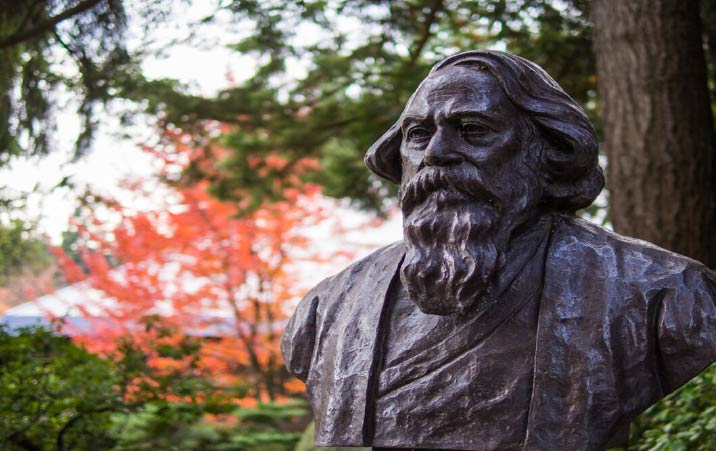The National Education Policy (NEP)-2020 captures the nation’s imagination in terms of bringing a systemic change to liberate the drudgery of erstwhile academic interventions in the primary, secondary and tertiary levels. It’s indeed an important endeavor of the govt. to have set a lofty goal of increasing the gross enrollment ratio (GER) to 50% by 2030 from the present 30%.
Though I am not critiquing the agenda of looking forward, I believe if we could have poised and pondered a bit, we could have identified there’s already a couple of successful models worth inspiring – one being Tagore’s Visva Bharati. Gurudev Rabindranath Tagore’s school of learning at Santiniketan breathes a fresh air initially subjected to criticisms and later went on become an iconic example in the firmament of education across India.
Most of the times the name of the reticent poet is referred to, the mention of his writings, plays, poems and songs clutter our little minds. We talk the least about the academic administrator and innovator in him who gave us an alternative to regimented education imported from the West.
A few days back, we celebrated his 160th birth anniversary. The time could not have been more opportune for me to write about the nuances of NEP 2020, which are imbued with the glimpses of Tagore’s resilience and philosophical marvels. Being an alumnus of Visva Bharati and a teacher myself, I feel there should be equal weightage for the summative as well as formative assessments of the students where a reengineering of the present evaluation system is highly warranted.
Tagore was a firm believer in the all-around development of a child’s personality encouraging aesthetic development governed by naturalistic values. More importantly, the poet lived his life in vehement denial of the influence of fractal dimensions in education as it is visible when he writes,” Don’t limit a child to your own learning, for he was born in another time.”
When Tagore established a school embellished with his ideals in 1901, he wanted to traverse a path less trodden by the then academia much influenced by the colonial dominance. His conviction of his model made his son Rathindranath Tagore join his school as the first student who went on to become a champion agricultural engineer and the first Vice-Chancellor of Visva Bharati in 1951.
The present policy on national education is the third in its line since India’s independence. The first national policy on education came in 1968 and was proposed by the Dr J S Kothari commission, the then chairman of UGC which had adopted a tri-language formula (regional, Hindi, and English) much similar to the present policy where the emphasis has been laid on teaching in regional languages.
The policy further advocated reaching out to the economically and socially disadvantaged sections of the society to make education a vehicle of inclusive growth, an idea widely propagated in the NEP 2020. It’s rather a predicament that in India, the knowledge of English is considered as a skill rather than a proficiency like any other language.
The second policy came up in 1986 in which open and distance learning (ODL) programs were encouraged and that’s when IGNOU was born in 1985. Another crucial aspect that got highlighted here was the pressing need to foster rural education much to the tune of Tagore’s philosophy of rural reconstruction, which he did with exemplary finesse in Sriniketan, Visva Bharati.
The vast expanse of methodological innovation ensembling theory and skill had illuminated the teaching ideals of Tagore thus he could establish two different segments offering outcome-based education (OBE) almost a hundred years back.
The NEP 2020 talks of establishing multidisciplinary universities dedicated to either teaching or research so that the unique pedagogical approaches could be brought to the surface by the teachers who are empowered and encouraged to pursue their interest in academics and help the students to chase their dreams.
Pathabhavana, a school founded by Tagore caters to the soft requirements of the students where music, dance, drama, elocution, and other activity-based learning whereas Siksha Satra, another school of Visva Bharati was set up in 1924 to encourage education among the rural folks with a precise focus of hands-on skill development.
Tagore firmly believed that the student cohorts have varying learning needs and freedom to learn at one’s own pace must be accorded to the students. Teachers must be endowed with academic freedom to pursue their passion in the larger interest of the society and no doubt his school once boasted teachers like Nandalal Bose, Ramkinkar Baize or Khitimohan Sen to name a few.
Visva Bharati was an institution with a difference that took the lifelong dedication of many such stalwarts who believed in the pedagogic philosophy of Tagore which were indigenous, scientific yet extended a stress-free and happy learning experience to the pupils.
For instance, open-air classes and compulsory music classes at the school level work as a major stress buster as the students assimilate themselves in the oneness of self and environment. It is quite fascinating to see that the NEP 2020 reverberates with the same recommendations as Tagore has envisaged.
